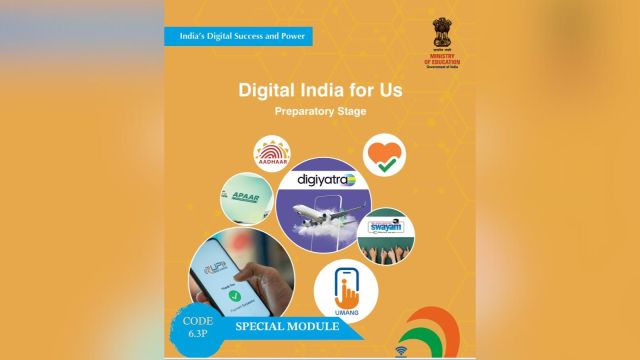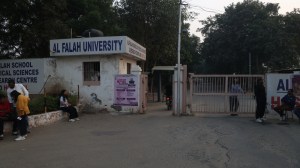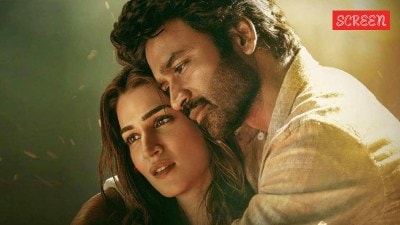NCERT’s new modules unpack India’s journey: From digital boom, Covid lessons to global power moves
The seven modules cover a wide range of subjects: Swachhata (cleanliness); Covid-19 Management, Asian Games Sporting Success (includes Khelo India games); Bharat – Mother of Democracy, India as Fifth Economic Power; India’s Digital Success and Power; and Virasat aur Vikas (Heritage and Development).
 These latest offerings follow a previous set of NCERT modules launched last year on India’s G20 Presidency, Viksit Bharat, and Nari Shakti Vandan.
These latest offerings follow a previous set of NCERT modules launched last year on India’s G20 Presidency, Viksit Bharat, and Nari Shakti Vandan.-When Nisha lost her degree certificate just before a job interview, she recovered it within minutes using DigiLocker.
-In rural Assam, a family used the Ayushman Bharat app to get emergency care for a critically ill patient.
-Elsewhere, a group of students, “concerned about local pollution levels became data detectives” — they accessed government air quality data, made verified social media accounts using Aadhaar and DigiLocker, launched a social media campaign with the hashtag #CleanAirCleanTown, and presented their findings to local authorities, prompting real action.
These real-world examples are now part of a new learning module released by the National Council of Educational Research and Training (NCERT) for students from Grades 1 to 12.
Titled India’s Digital Success and Power, it is one of seven modules launched by Union Education Minister Dharmendra Pradhan on May 19 in Delhi. It aims to integrate real-life learning and national themes into the school curriculum.
The seven modules cover a wide range of subjects: Swachhata (cleanliness); Covid-19 Management, Asian Games Sporting Success (includes Khelo India games); Bharat – Mother of Democracy, India as Fifth Economic Power; India’s Digital Success and Power; and Virasat aur Vikas (Heritage and Development).
They are designed for four stages of schooling — foundational, preparatory, middle, and secondary — and use a mix of stories, case studies, quiz questions, and interactive activities.
According to a statement from the Ministry of Education, the modules “reflect India’s belief in ‘language as cultural identity’ and ‘education as empowerment’.”
They have been made available this month digitally via the NCERT’s website.
The modules: A breakdown
Digital India: One preparatory-level story shows a mother using a UPI app to pay at a bookstore after forgetting her wallet, introducing digital finance in a relatable way. When the character Lucky injures his arm, he continues learning through videos and worksheets on the DIKSHA app — underlining how technology plays a role in education access, even at an early age.
At the middle and secondary stages, students are introduced to platforms such as Aadhaar, DigiLocker, Ayushman Bharat Digital Mission, DigiYatra, UMANG, and the Government e-Marketplace (GeM). A case study features Brij Kishor, a jewellery artisan from Rajasthan, who uses GeM to sell his products across India, including to a government office, revealing how small businesses are being supported through public digital infrastructure.
Mental health services are another focus area. One narrative follows a student named Riva who accesses India’s national mental health helpline, Tele MANAS (14416), after feeling overwhelmed. The story opens a conversation around digital access to emotional support and care.
Democracy: It explores voting traditions from Buddhist sanghas and Chola-era Kudavolai systems to the structure of modern electoral institutions. For secondary school students, ‘The Idea of Welfare state in Kautilya’s Arthashastra’ is another module prepared.
Covid-19: Presents the pandemic through both science and storytelling.
At the foundational level, students match symptoms like fever, fatigue, and breathing trouble with illustrated posters they may have seen during the pandemic. One activity invites them to tick off what they experienced during Covid: “Did you feel tired? Did you have a cough? Could you smell your food?”
For older students, there’s an exercise to build a 3D model of the virus using eco-friendly material and another that asks them to interview COVID-affected individuals and document long-term effects, bridging health science with personal experience.
Swachhata: For young learners, it introduces a colourful character called the “Swachhata Wizard” who guides children through a role-play in a messy playground. He is joined by animated characters like the Blue Bin (for recyclable waste), the Green Bin (for non-recyclable waste), and a Sorting Robot. Together, they teach students about composting and segregation.
Secondary-level students, meanwhile, discuss how individual behaviour shapes public health. “When our daily actions reflect cleanliness,” says a teacher character, “the country doesn’t need a separate campaign”
Sports: Real-life examples from the 2023 Asian Games — where India won a record 107 medals — are used to inspire students. It features sportspersons like Neeraj Chopra and Parul Chaudhary and how 125 athletes were trained under the Khelo India scheme.
One classroom dialogue reads: “Can someone bring glory to the nation without joining the defence services?” A teacher responds, “Yes, through sports,” and then introduces achievements like winning all five golds in archery and the rise of India’s para-athletes.
Virasat aur Vikas: This explores how India’s cultural legacy intersects with modern development. According to the module guidelines, it “seeks to instil in the minds of the children at the middle and secondary stages a sense of pride in our heritage, have a feeling of belongingness, and at the same time have a global perspective”.
Students are introduced to sites such as the Shri Kashi Vishwanath temple in Varanasi and the Kamakhya temple in Assam, with references to recent government efforts like the Maa Kamakhya Divya Lok Pariyojana.
Students are also encouraged to “write scripts for drama on legend or stories associated with monuments” or “develop a multilingual glossary of terms used in the context of culture”.
These latest offerings follow a previous set of NCERT modules launched last year on India’s G20 Presidency, Viksit Bharat, and Nari Shakti Vandan.







